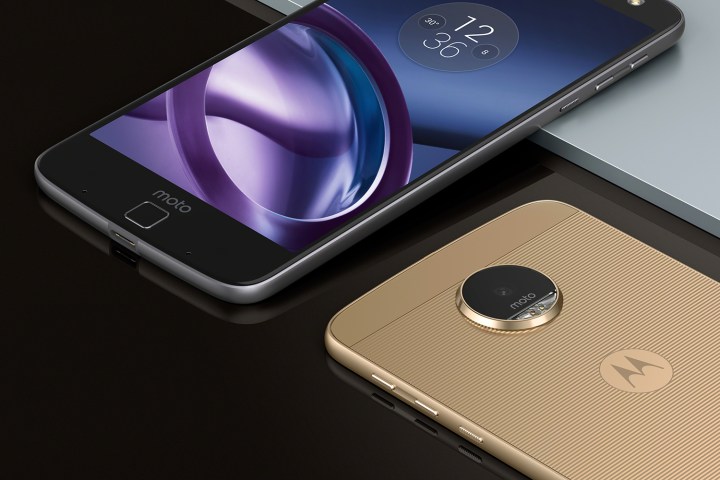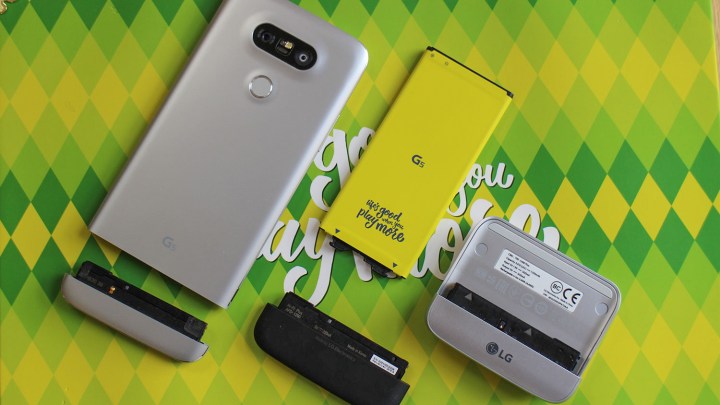
|
Lenovo Moto Z |
LG G5 |
|
| Size | 153.3 × 75.3 × 5.2 mm (6.0 × 3.0 × 0.2 in) | 149.4 × 73.9 × 7.7 mm (5.9 × 2.9 × 0.3 in) |
| Weight | 4.80 ounces | 5.61 ounces |
| Screen | 5.5-inch AMOLED | 5.3-inch LCD |
| Resolution | 2,560 × 1,440 pixels, 535ppi | 1,440 × 2,560 pixels, 554ppi |
| OS | Android 6.0 Marshmallow | Android 6.0 Marshmallow |
| Storage | 32/64GB | 32GB |
| SD Card Slot | Yes | Yes |
| NFC support | Yes | Yes |
| Processor | Qualcomm Snapdragon 820 | Qualcomm Snapdragon 820 |
| RAM | 4GB | 4GB |
| Connectivity | Wi-Fi, LTE, GSM, CDMA, HSPA+, EVDO, UMTS, Edge | Wi-Fi, 4G LTE, HSPA+, GSM, CDMA |
| Camera | Front 5MP, Rear 13MP | Front 8MP, Rear 16MP + 8MP |
| Video | 4K | 4K |
| Bluetooth | Yes, version 4.1 | Yes, version 4.2 |
| Fingerprint sensor | Yes | Yes |
| Water Resistant | No | No |
| Battery | 2,600mAh | 2,800mAh |
| Ports | USB-C (No headphone jack) | Micro USB, 1/8″ |
| Quick Charging | Yes | Yes |
| Wireless Charging | No | No |
| Color offerings | Black with gold trim, black with grey trim, white and gold | Silver, titan, gold, pink |
| Availability | Verizon in summer, unlocked in fall | AT&T, Verizon, Sprint, T-Mobile |
| DT Review | Coming soon | 4 out of 5 stars |
Specs

Both of these phones are flagship devices built for 2016, so you would expect the specs of the phones to be pretty similar — and similar they are. Both phones boast Qualcomm’s Snapdragon 820, coupled with 4GB of RAM. In other words, both devices should be very responsive and capable of handling even the most processor-hungry apps for the next few years.
Storage is where things vary, though not by much. The Moto Z comes in either a 32GB or 64GB configuration, while the G5 is limited to a 32GB model. Both offer MicroSD card slots, though, so you can always add more storage if need be.
Network connectivity is another area in which the two phones vary, especially considering that it’s still unclear what networks the Moto Z will work on when it launches in the fall. The spec page for the Moto Z suggests that the phone works with CDMA networks, however recent reports indicate that the unlocked version will be GSM-only. In other words, you won’t be able buy an unlocked version of the Moto Z and bring it to Verizon or Sprint — you’ll have to buy the device directly from the carrier. The G5, on the other hand, is available from all major carriers, and unlocked for any carrier you so choose.
When it comes to specs, each of the two devices has its own advantages. The Moto Z has more storage potential, sure, but the G5 offers more wireless compatibility. That said, this one’s a tie.
Winner: Tie
Design

Both of the phones are handsome devices, but the Moto Z really seems to take things to the next level — so much so that Lenovo claims that it’s the thinnest phone available, and it almost is at a mere 5.2-millimeters thick. The G5, on the other hand, measures 7.7-millimeters thick.
Being extremely thin isn’t the only thing the Moto Z has going for it in terms of design. The phone’s metal, unibody frame gives it a premium feel, though it does leave it more susceptible to fingerprints. Perhaps the biggest drawback to the Moto Z’s design is it’s protruding camera — and boy does that camera protrude. Still, the effect can be minimized using Moto Mods on the back, which will add to the thickness and make the back a little smoother.
The G5 is far less flashy with its all-metal body. The camera does protrude, however it does so much more subtly. While less flashy, the G5 still touts a beautiful design, albeit a minimalist one. It also has a fingerprint sensor on the back, whereas the Moto Z’s fingerprint sensor is on the front. That’s not really better or worse, just different.
However, there’s an elephant in the room when it comes to design — the headphone jack. The Moto Z doesn’t have one, nor could it to achieve its thin build. The headphone jack is arguably on its way out the door, sure, but it’s still an omission for the time being. That said, you’ll still be able to use wired headphones with a USB-C adapter. In fact, through USB-C, you’ll even be able to use powered headphones that lead to better audio quality.
You can’t compare the Moto Z and the G5 without talking about mods, and this is another area where Lenovo simply seems to be better. Sure, the G5’s mods are interesting, but they aren’t very inventive and require you to pull pieces out of your phone. With the Moto Z’s magnetic build, you simply need to snap mods onto the back. We’ll talk about actual mods later on, but the design of the mods is clearly better with the Moto Z.
In review, the Moto Z is thinner, looks more premium, and has a better mod design. It may lack a headphone jack, but thickness is a fair trade-off, especially when Bluetooth headphones and USB-C headphones are becoming the norm. Such being the case, the Moto Z wins in terms of design.
Winner: Lenovo Moto Z
Display

When it comes to the display, both devices have their pros and cons. The Moto Z has a larger, 5.5-inch display, while the G5 touts a 5.3-inch panel. However, because the devices have the same display resolution (1,440 x 2,560), the G5’s display is slightly sharper. Of course, display technology is an important difference in and of itself. Whereas LG opted for an LCD display with the G5, Lenovo went with an AMOLED one. In other words, the display on the Moto Z will offer clearer colors and deeper blacks, which puts the Moto ahead of the G5 in regards to the display.
Winner: Lenovo Moto Z
Camera

The Moto Z offers a pretty huge camera bump, and while the technology inside that bump isn’t bad, it doesn’t really stack up against the G5. The Moto Z’s camera has a 13-megapixel sensor with optical image stabilization and laser autofocus, however neither of those features are enough to put the Moto Z ahead of the G5 in the camera department. The G5 offers both a 16-megapixel camera and an 8-megapixel wide-angle camera — perfect for varied shots. While the second lens doesn’t feel as premium as the other due to the lowered megapixel count, the wide-angle lens can be super beneficial in certain situations.
As far as aperture goes, the Moto Z’s shooter has an aperture of f/1.8 while the G5 has an f/2.0 aperture, which makes the Moto Z a little better in low-light situations. Still, that remains to be seen. The Moto Z also touts a 5-megapixel camera on the front, while the G5 opts for the 8-megapixel equivalent.
With the option of two rear-facing cameras and a higher megapixel count on both the rear-facing and front-facing camera, we’re going to have to give this one to the LG G5.
Winner: LG G5
Mods

As previously mentioned, the design for “Moto Mods” on the Moto Z is clearly better than the mods on the G5 — but what about the mods themselves? Interestingly enough, while the G5 has been out for a while now, there aren’t many modules available for the device just yet. There’s really only a camera mod available at the moment, though, there’s also a speaker mod exclusive to European markets.
The Moto Z, however, will have a battery module, speaker module, and even a projector module at launch. You can also buy “mods” that are purely aesthetic, which add little bulk and a ton of color. Not only that, but mods are far easier to use on the Moto Z given the magnetic design. You simply snap them on, so there’s no need to remove parts when you want to add modules like you have to with the G5.
Clearly LG was innovative by introducing one of the first modular phones. Unfortunately for LG, Lenovo does it a lot better. We’re handing this one over to the Moto Z.
Winner: Lenovo Moto Z
Software

Under Google’s direction, Motorola used near stock Android as its software, something that seems to have continued under Lenovo for the time being. For the Android experience as Google intended it, you’re going to want to opt for the Moto Z.
LG’s latest offering takes things in a different direction. The company’s Optimus UX changes almost every visual aspect of Android, and bundles a number of apps and services into the mix. It’s a very colorful take on Android, and while LG is clearly trying to get you to sign up for some of its own services so it can make more money, it’s an interesting take on Android and one that many people are sure to enjoy.
One thing to consider, however, is how quickly you want updates. Because the Moto Z has almost stock Android, it’s likely to get updates far quicker than the G5, as it takes a lot less development once an update has been released. If you want quick updates, go for the Moto Z.
This writer is a stock Android fan, but this clearly comes down to personal preference, and we’re not going to go one way or the other.
Winner: Tie
Winner: Lenovo Moto Z

Both the LG G5 and the Lenovo Moto Z are firmly in flagship territory for 2016, however the Moto Z simply seems a little more so than the G5. The G5 has its advantages — the built-in cameras, for instance — but in most other categories, the Moto Z is the clear winner. That, of course, makes sense. The tech world is advancing pretty quickly, and even a device that’s a few months newer can wipe the floor with a slightly older one. The Moto Z is better designed, has better specs, and features more mods. While we don’t know pricing and availability quite yet, if it ends up being in a similar price range as the G5 ($650 unlocked), it’s a no-brainer.





